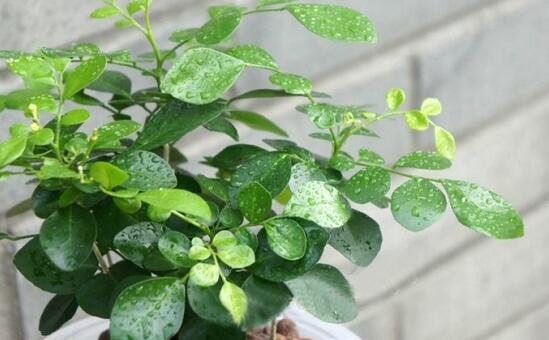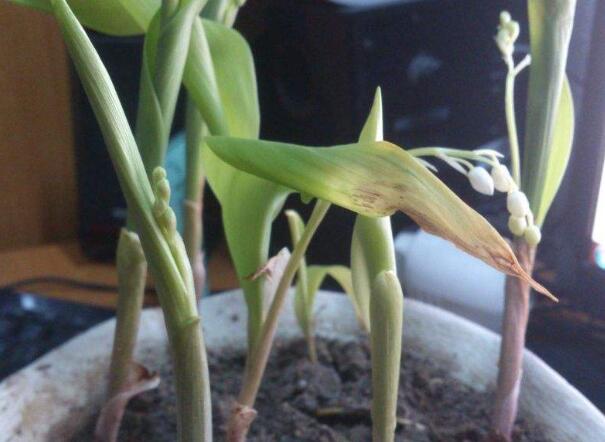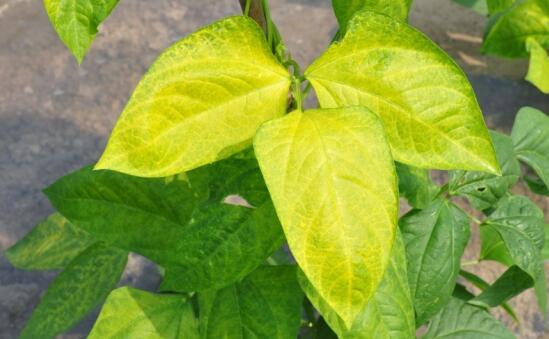How to do if the leaves of Jiuli incense turn yellow, pay attention to 5 points to solve easily / too little light and insufficient water
As a good product of indoor culture, many flower friends will plant Jiuli incense at home. It not only has beautiful plants and beautiful flowers, but also smells very good, so it is very popular. However, in the process of breeding, due to various reasons, there will be symptoms of yellow leaves, that nine incense leaves yellow how to do? Next, the editor will answer the questions for you.
One, nine incense leaves yellowing how to do, find the cause

In the culture method of Jiuli incense, we introduced the relevant requirements of Jiuli incense, and once we fail to meet the requirements, the leaves of Jiuli incense will turn yellow. As for the yellowing of Jiuli incense leaves, we should first find the cause, and then solve the problem. The following are the reasons for the yellowing of the leaves summarized by the editor, and the solutions are attached. Let's move on.
Second, what is the cause of the yellowing of Jiuli incense leaves / solutions
1. Environmental mutation
When it comes to the yellowing of Jiuli incense leaves, there are actually many reasons, but the first thing that comes to mind is the environment. Because if your Jiuli incense is bought online, it may not adapt to the great changes in the growth environment, and the leaves will turn yellow after a period of time.
Solution: before buying, communicate with the shop owner to understand the growing environment of Jiuli incense, and keep it the same after buying it back. Even if you want to change the environment, you have to gradually let it have an adaptation process. If the leaves are yellow caused by the environment, flower friends can put Jiuli incense in a ventilated place and wait until the plant returns to normal before taking care of it in the normal way.
2. Lack of light
In the process of breeding Jiuli incense, we need to give it enough light, once we do not provide it with sufficient light, or put her in the dark for a long time, the leaves of Jiuli incense will turn yellow.
Solution: give Jiuli incense enough light time, if placed indoors, it is best to choose a place with plenty of sunshine. If you can't keep it in the sun all day, you should spend at least 5 to 6 hours in the sun every day.
3. Improper watering
In addition to the environment and light, improper watering is also one of the reasons why the leaves of Jiuli incense turn yellow. It is understood that Jiuli incense is very sensitive to moisture, so we should not water it too frequently or dry thoroughly. Too dry and wet will lead to poor plant growth, resulting in withered and yellow leaves and even shedding.
Solution: water too much, immediately stop watering, it is best to loosen the soil, let the water evaporate; water too little, in order to prevent water loss, immediately put Jiuli incense in the semi-shady place, and a little water, not more than one time. At the same time, the strong gap in the basin wall is loosened to drain water from the gap.
4. Red spiders of diseases and insect pests
In addition to the above, diseases and insect pests are also the cause of the yellowing of Jiuli incense leaves. It is understood that the red spider is one of the diseases and insect pests of Jiuli incense. It survives by absorbing the juice of the leaves of Jiuli incense. If it is not removed in time, the plant will become malnourished, resulting in leaf yellow symptoms.
Solution: when you find a red spider, you should spray it in time. You can choose to spray 2000 times of triclofenac EC and spray it a few more times.
5. The leaves of Jiuli incense turn yellow in winter
It is worth mentioning that in winter, Jiuli incense leaves are very easy to turn yellow. The main reasons are: 1, the basin soil is too dry or too wet; 2, the environment is not circulating; 3, dry and muggy.
Solution: keep the basin soil moist in winter, ensure that it is not dry or wet, maintain indoor ventilation, and control the room temperature above 5 ℃. In order to ensure that the air is not dry, the frequency of foliar water spraying can be increased appropriately.
Generally speaking, Jiuli incense is relatively easy to raise, but in the breeding process, do not leave, the plant will have all kinds of problems. But now that we have raised it, we should raise it well, so we must be careful to avoid the emergence of Ye Huang. With regard to the yellowing of the leaves of Jiuli incense, the editor has introduced it here, hoping to give you some help.
What are the culture methods of Jiuli incense?
Jiuli incense has beautiful appearance, beautiful branches and leaves, full-bodied flowers in flowering season, and has a very high ornamental value. It is one of the common plants in art gardens and family courtyards. So what are the breeding methods of Jiuli incense in life? let's take a look at the breeding methods of Jiuli incense with the editor.
The first culture method of Jiuli incense: growing environment
Jiuli incense likes to grow in a humid environment, so it is not suitable for indoor breeding, it is best to put it in a ventilated and semi-shaded place, the temperature in spring and autumn is the most suitable for the growth of Jiuli incense, and in summer, you should pay attention to sunscreen, and it should be kept warm in winter. It should be put into the greenhouse, and the indoor temperature should not be lower than 5 degrees. The temperature is too high or too low will affect its growth rate.
The second culture method of Jiuli incense: fertilization
In the cultivation of Jiuli incense, fertilizer is also an essential nutrient, which can promote the growth of branches, leaves, flowers and fruits, and promote the growth of stems and important parts, so it should be fertilized at regular intervals to make there are enough nutrients in the soil. however, in the process of fertilization, we should also pay attention to the right amount, not to apply too much fertilizer at one time, otherwise it will have the opposite effect.
The third culture method of Jiuli incense: moisture
Water is indispensable to any plant, so it is also very important to cultivate Jiuli incense. It should be noted that the tap water should be stored in a water tank for a day before use, and the watering tool had better use a spray can with a showerhead. Only in this way can the water be distributed evenly and Jiuli incense can be absorbed better, but it should also be properly absorbed in the watering process. If there is too much water, it will lead to yellow leaves, rotten roots and other phenomena, affecting its growth.
Conclusion: the above is the breeding method of Jiuli incense introduced by Xiaobian. Jiuli incense is a kind of plant with strong vitality and good breeding. As long as you pay a little attention to it in the process of breeding, watering and fertilizing it every once in a while, to ensure that the nutrients in the soil are sufficient, it will grow quickly and give beautiful flowers to repay you. [related links]: how do ⊙ peonies raise ⊙ rich bamboo yellowing how to ⊙ ivy culture methods ⊙ bananas when to eat the best ⊙ white orchids how to raise ⊙ June snow culture methods ⊙ blue witches represent what the efficacy and function of ⊙ half lotus leaves yellowing ⊙ triangular plum culture methods ⊙ culture methods ⊙ kiwifruit culture methods
The culture method of loose-tailed sunflower
Loose-tailed sunflower is native to Madagascar, Africa. Because of its chic and beautiful shape and evergreen seasons, loose-tailed sunflower plants are widely cultivated in various tropical areas of the world. They are widely introduced and cultivated in China, and they are a kind of potted ornamental plants. In addition, loose-tailed sunflower also has the function of absorbing harmful gases. Here, the editor will combine the pictures of loose-tailed sunflower to tell you about the breeding methods and the role of loose-tailed sunflower. [loose-tailed sunflower] the culture method of loose-tailed sunflower, the function of loose-tailed sunflower, loose-tailed sunflower picture-
[plant archives]-
English name: sunflower
Scientific name: Chrysalidocarpuslutescens
Aliases: yellow coconut, Aoi Murasaki
Family: Palmaceae
Genus: Abelmoschus
Distribution of origin: originally from Madagascar in Africa, it is now cultivated in all tropical regions of the world.
Morphological features: tufted evergreen shrubs or small trees. Petiole, leaf rachis, leaf sheath are yellowish green; leaf surface slippery and slender, simple, pinnatifid, 40-150 cm long, petiole slightly curved, apex soft; leaf sheath cylindrical, phimosis. Inflorescences of fleshy spike paniculate, born under leaf sheath, multi-branched, about 40cm long, 50cm wide; stem smooth, yellowish green, no burr, waxy powder when tender, obvious leaf marks, ring-shaped; flowers small, golden yellow, florescence 3-4 months. Fruit suborbicular, long 1.2cm, wide 1.1cm, orange. Seeds 1-3, ovate to oval. There are many tillers at the base, showing tufted growth.
[properties of traditional Chinese medicine]-
[name] loose tail sunflower
[taste] slightly bitter, astringent, cold. Enter the liver meridian.
[efficacy] restrain and stop bleeding.
[indications] it can be used for all kinds of hemorrhagic disease. Such as epistaxis, gingival bleeding, hematemesis, hematochezia, skin bleeding and so on.
Internal use: fried soup, 9-15g. External use: carbon burning research powder is sprayed on the bleeding area
[purpose] restrain and stop bleeding.
[medicinal material source] is the leaf sheath of Sunflower of Palmaceae.
How to raise sunflower
◆ growth habits: sexual preference for warm, humid, semi-shady and well-ventilated environment, not cold-resistant, shade-tolerant, afraid of the hot sun; leaves yellowing below 20 ℃, the lowest temperature for overwintering should be above 10 ℃, and it will freeze to death at about 5 ℃. It can still be cultivated in the open field in South China, and the Yangtze River basin and its northern areas should be maintained in the greenhouse.
◆ environmental requirements: sunflower is afraid of cold, cold tolerance is weak, the growing season must keep the basin soil moist and the air humidity around the plant.
◆ watering: in the overwintering period, we should also pay attention to scrubbing or spraying a small amount of water to the leaf surface to keep the leaf surface clean.
◆ fertilization: generally loose tail sunflower needs to apply rotten liquid fertilizer or compound fertilizer every 1-2 weeks to promote plant vigorous growth, thick green leaves, less fertilization or no fertilization in autumn and winter.
◆ basin soil: in loose-tailed sunflower culture, should provide more adequate water and fertilizer conditions. Always keep the basin soil moist at ordinary times. Summer and autumn high temperature period, but also often maintain a higher air humidity around the plant, but avoid basin soil stagnant water, so as not to cause rotten roots.
◆ soil: sunflower is suitable to grow in loose, well-drained, humus-rich soil to keep the basin soil dry and wet.
◆ temperature: sunflower is afraid of cold and has weak cold tolerance. The lowest temperature for overwintering is above 10 ℃. The country of origin can be as high as 380 m. Outdoor culture in northern China usually enters the room from late September to early October and must be placed in a place with sufficient sunshine. During the overwintering period, the room temperature is 23 ℃ to 25 ℃ in the daytime and 15 ℃ at night, or at least 8 ℃ or more, otherwise it will suffer frost injury and cause death in winter and spring.
◆ disease and insect pests: red spiders and shell insects are very easy to occur in loose-tailed sunflower culture, so it should be sprayed with 800x omethoate regularly.
The culture method of loose-tailed sunflower
The pot cultivation of loose-tailed sunflower can be made into culture soil with rotten leaf soil, peat soil plus 1x3 river sand and some base fertilizer. Its tillering bud growth is more on the rhizome, potted, because it is a little deeper than the original, so that the new buds take root and grow better.
In fact, loose-tailed sunflower culture is not very difficult, you can also use sowing reproduction and ramet reproduction. The seeds used for sowing and reproduction should not be collected domestically and are mostly imported from abroad. The conventional multi-purpose ramet was carried out around April, combined with changing pots, selecting the plants with many tillers in the basal part, removing part of the old basin soil, and dividing it into several clusters from the junction of the base with a sharp knife. Each clump should not be too small, there must be 3 plants of 2murl, and keep the root system well, otherwise the growth of ramet will be slow and the ornamental will be affected. After planting, it was placed in a high humid temperature environment, and often sprayed with water to facilitate the recovery of growth.
The role of sunflower-
◆ garden use: garden ornamental, anti-sulfur dioxide. In tropical courtyards, most ornamental trees are planted in grasslands, shade and houses; in the north, they are mainly used for potted plants, which are high-grade potted foliage plants decorating living rooms, dining rooms, conference rooms, family rooms, study rooms, bedrooms or balconies.
You can also watch it for 4-6 weeks in a darker room. Loose-tailed sunflower grows very slowly and is generally planted in medium and small pots. Sunflower leaves can also be used to cut leaves in flower arrangement as a foil in flower arrangement.
◆ home environment function: as a small palm plant sunflower, it has strong negative tolerance. After the home decoration, put a pot of sunflower, it is difficult to effectively remove benzene, trichloroethylene, formaldehyde and other volatile harmful substances in the air.
Conclusion: in a darker room, sunflower can be watched continuously for 5-7 weeks, and it is one of the plants with high ornamental value. Of course, as a green palm leaf plant, it is not only ornamental, but also has an effective purification effect on p-xylene and formaldehyde. It is a kind of modern home decoration, office decoration, opening congratulations, housewarming, holiday gifts and other good choice plants.
[more Encyclopedia of plants]
Efficacy and function of flower culture of tequila, canna, jasmine, ferns and bonsai lilies in hydroponic culture of rich bamboo and mint
Smooth sailing culture methods Phnom Penh tiger skin orchid Kunlun snow chrysanthemum efficacy daffodils poisonous Magnolia flower language Violet blue witch
Why is mimosa shy? spring primrose bonsai cyclamen Ping an tree dripping Guanyin culture method Jasper culture method fragrant wood
Chinese rose June snow bonsai hydrangea culture method of mosquito repellent grass how to raise jade tree culture method Jiuli incense bonsai acacia
- Prev

What about the yellowing of the leaves of the orchid, breeding in indoor semi-shade / timely treatment of diseases and insect pests
The orchid of the bell, is a kind of white flower, gives a kind of pure flawless feeling, has the extremely high ornamental value. It is because it looks so clean, otherwise, if there is a yellowing flower, it will destroy its overall beauty. What to do about the yellowing of the leaves of the orchid actually has something to do with many aspects.
- Next

What if the leaves of the mulberry flowers turn yellow? pay attention to the yellowing at 5 o'clock. / lack of light and fertilization is too little.
As a good product of indoor culture, Fusang flower is favored by many flower friends because of its beautiful shape and bright red color, and keeps it at home. However, in the process of breeding, due to improper maintenance and other problems, the plant will show symptoms of yellow leaves, then what about the yellowing leaves of mulberry flowers?
Related
- Fuxing push coffee new agricultural production and marketing class: lack of small-scale processing plants
- Jujube rice field leisure farm deep ploughing Yilan for five years to create a space for organic food and play
- Nongyu Farm-A trial of organic papaya for brave women with advanced technology
- Four points for attention in the prevention and control of diseases and insect pests of edible fungi
- How to add nutrient solution to Edible Fungi
- Is there any good way to control edible fungus mites?
- Open Inoculation Technology of Edible Fungi
- Is there any clever way to use fertilizer for edible fungus in winter?
- What agents are used to kill the pathogens of edible fungi in the mushroom shed?
- Rapid drying of Edible Fungi

